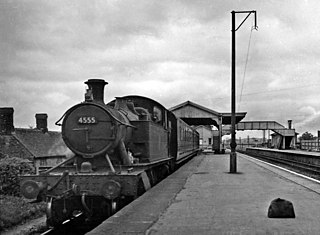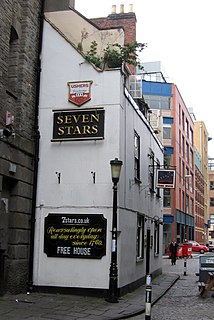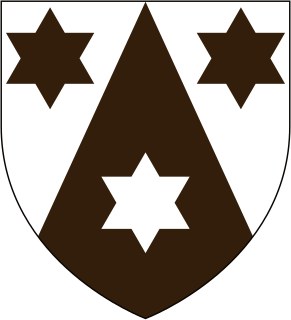Related Research Articles

The Priory Church of St Bartholomew the Great, sometimes abbreviated to Great St Bart's, is a mediaeval church in the Church of England's Diocese of London located in Smithfield within the City of London. The building was founded as an Augustinian priory in 1123. It adjoins St Bartholomew's Hospital of the same foundation.
Amersham Hall was a "school for the sons of dignified gentlemen" in England. From 1829 to 1861 it was in Elmodesham House in Amersham, Buckinghamshire, relocating in 1861 to Caversham in Oxfordshire. The Caversham site, a suburb in the north of Reading and now in Berkshire, currently houses Queen Anne's School.

Witham (Somerset) railway station was a station serving the Somerset village of Witham Friary and was located on the Frome to Yeovil section of the Wilts, Somerset and Weymouth Railway that opened in 1856.

Blackfriars, Gloucester, England, founded about 1239, is one of the most complete surviving Dominican black friaries in England. Now owned by English Heritage and restored in 1960, it is currently leased to Gloucester City Council and used for weddings, concerts, exhibitions, guided tours, filming, educational events and private hires. The former church, since converted into a house, is a Grade I listed building.

Seven Stars is a historic pub on Thomas Lane, Bristol, England; it was built in the 17th century and is a grade II listed building.

St Ann Blackfriars was a church in the City of London, in what is now Ireland Yard in the ward of Farringdon Within. The church began as a medieval parish chapel, dedicated to St Ann, within the Dominican Black Friars church. The new parish church was established in the 16th century to serve the inhabitants of the precincts of the former Dominican monastery, following its dissolution under King Henry VIII. It was near the Blackfriars Theatre, a fact which displeased its congregation. It was destroyed in the Great Fire of London of 1666.
Donnington Friary was a friary of crouched friars at Donnington in the English county of Berkshire. At the time of suppression the establishment was recorded as Trinitarian, but this was later corrected to Crossed Friars. This was possibly a ploy by the two brothers in occupation at the time in order to ensure their pension.

Austin Friary was an Augustinian friary in Bristol, England. It was established in 1313, when Simon de Montecute gave 100 square feet (9.3 m2) of land within the Temple Gate of Bristol. Further gifts of land were made by William de Montecute and Thomas of Berkeley during the next thirty years.

Blackfriars, Bristol was a Dominican priory in Broadmead, Bristol, England. It was founded by Maurice de Gaunt in 1227 or 1228. Llywelyn ap Dafydd, son of Dafydd ap Gruffydd, the last native Prince of Wales, was buried in the cemetery of the priory. Following the Dissolution of the Monasteries in the 16th century, surviving parts of the priory became a guildhall for the Smiths and Cutlers Company, the Bakers Company, a workhouse and then a meeting house for the Quakers. In the 20th century, it has housed the local Register_office_(United_Kingdom), a theatre company, and a restaurant.

Greyfriars, in Bristol, England, was a Franciscan friary. The name Greyfriars derived from the grey robes worn by the friars. It was founded at some time before 1234, within the town walls and then moved to Lewin's Mead in 1250. The site included extensive gardens surrounded by a stone wall. Following the Dissolution of the Monasteries in the sixteenth century, the premises were leased to the town council in 1541, who desired to use the stone to make repairs to the town walls, and the harbour facilities. In succeeding centuries many different uses have been made of the site, which is currently occupied by an office block and part of Bristol Dental School.

Whitefriars was a Carmelite friary on the lower slopes of St Michael's Hill, Bristol, England. It was established in 1267; in subsequent centuries a friary church was built and extensive gardens developed. The establishment was dissolved in 1538.
Sack Friary, Bristol was a friary in Bristol, England. It was established in 1266 and dissolved in 1286.
Gillingham Friary was a friary in the town of Dorset, England.
Wotton under Edge Friary was a friary in Wotton-under-Edge, Gloucestershire, England.

Greyfriars, Gloucester, England, was a medieval monastic house founded about 1231.

Whitefriars, also known as White Friers or The College of Carmelites, Gloucester, England, was a Carmelite friary of which nothing now survives.
Lancaster Friary was a friary in Lancashire, England. The buildings were approximately where Dalton Square is found today. It was active between 1260 and 1539. Nothing remains. Two archaeological trenches were dug in 1981 and 1994; they exposed some tiles and wall footings.

In London, the Greyfriars was a Conventual Franciscan friary that existed from 1225 to 1538 on a site at the North-West of the City of London by Newgate in the parish of St Nicholas in the Shambles. It was the second Franciscan religious house to be founded in the country. The establishment included a conventual church that was one of the largest in London; a studium or regional university; and an extensive library of logical and theological texts. It was an important intellectual centre in the early fourteenth century, rivalled only by Oxford University in status. Members of the community at that time included William of Ockham, Walter Chatton and Adam Wodeham. It flourished in the fourteenth and fifteenth century but was dissolved in 1538 at the instigation of Henry VIII as part of the Dissolution of the Monasteries. Christ's Hospital was founded in the old conventual buildings, and the church was rebuilt completely by Sir Christopher Wren as Christ Church Greyfriars after the original church was almost completely destroyed in the Great Fire of London of 1666. The building now standing on the site, designed by Arup Group Limited, is currently occupied by Merrill Lynch.

The Black Friar is a Grade II* listed public house on Queen Victoria Street in Blackfriars, London.
References
- 1 2 3 Corry, John; Evans, John (1816). "The History of Bristol, Civil and Ecclesiastical".
- ↑ About Bristol
Coordinates: 51°26′52″N2°35′10″W / 51.447842°N 2.586132°W